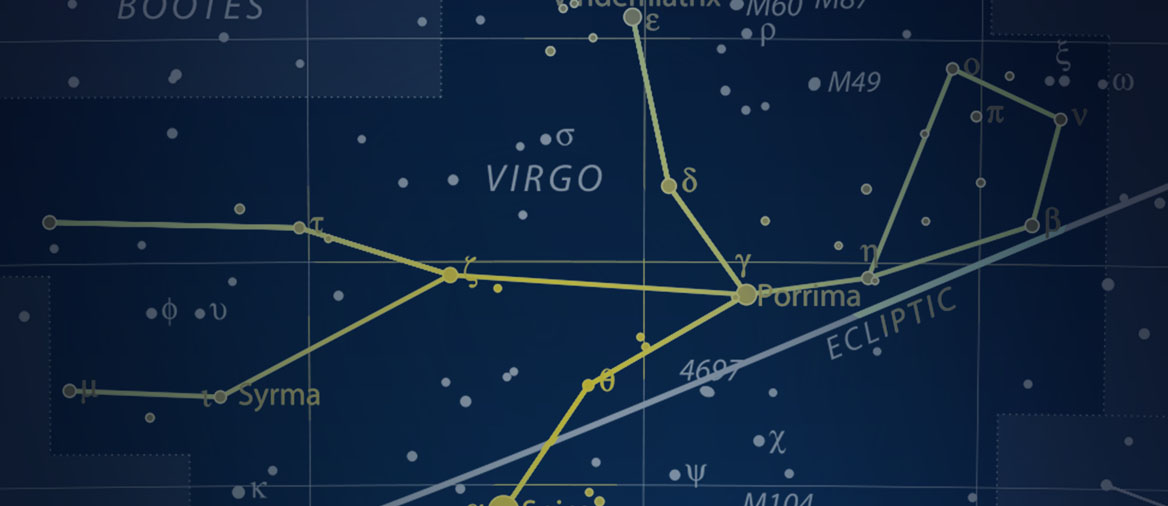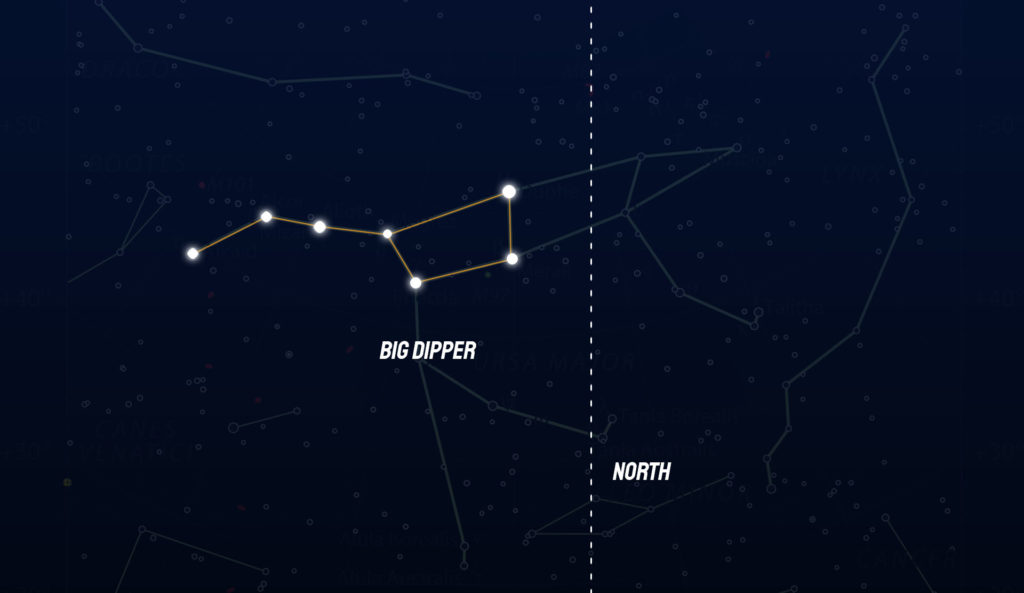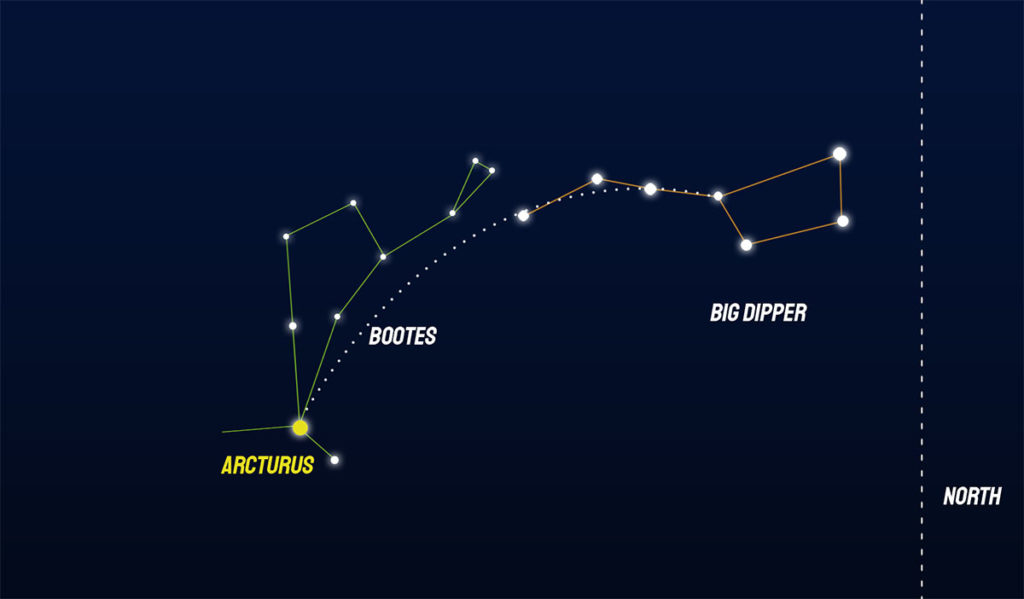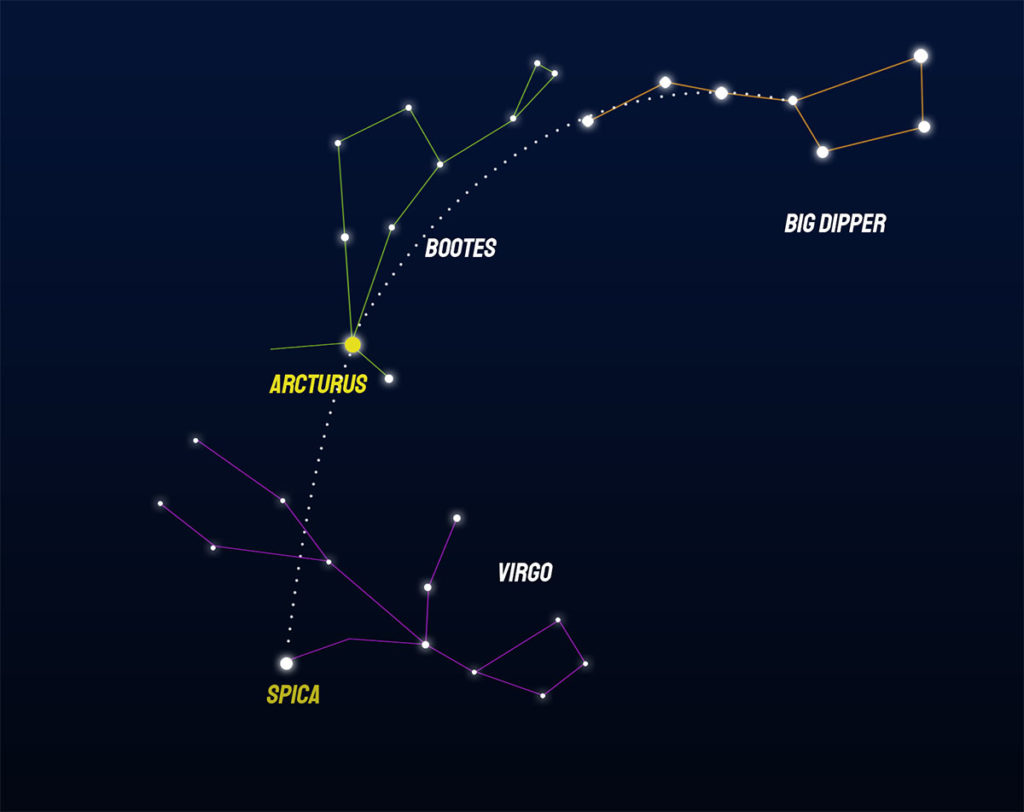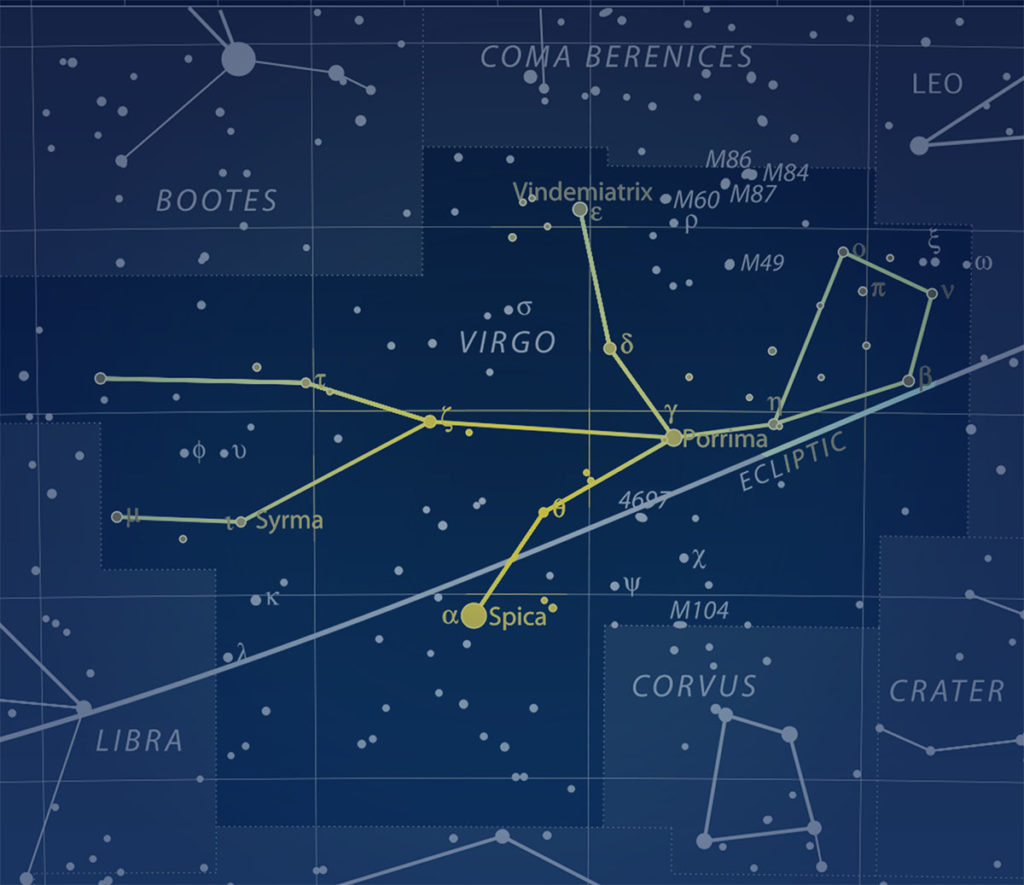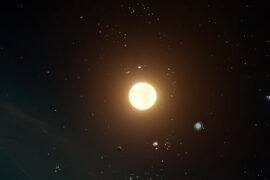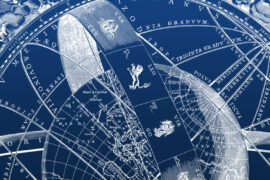Virgo is one of the 88 recognized constellations in the IAU catalog, and one of the 12 constellations of the zodiac. The zodiac constellations are a group of star formations that happen to cross the ecliptic line, which is the imaginary line Earth follows when it orbits around the Sun.
Learning how to find the Virgo constellation is a very simple process that you can master in just a few minutes. One of the considerations you will need to take into account is when to look for it as Virgo is only visible for about 9 months throughout the year.
First let’s take a look at some quick facts and details about Virgo:
| Name | Virgo |
| Meaning | The maiden |
| Abbreviation | Vir |
| Genitive (scientific name) | Virginis |
| Main stars | 15 |
| Bayer stars | 96 |
| Stars with planets | 29 |
| Brightest star | Spica (Alpha Virginis) |
| Meteor showers | Virginids, Mu Virginids |
| Location quadrant | SQ3 |
| Neighboring constellations | Bootes, Libra, Leo, Corvus |
When and Where to find Virgo in the sky
Virgo can be seen from latitudes between -80° to +80° which means it is visible almost anywhere in the world with the exception of both poles. It is visible from November to August, and the best time to observe it and when it is the easiest to find it is in June when it is located directly overhead at around 9:00 PM.
Because of Earth’s rotation, constellations are not visible all night long as they move across the sky. Depending on the month you are looking at the sky, you will find the constellations at different times.
The following table lists the times when Virgo is visible and when it is not for each month.
| Month | Visble | Not Visible |
| January | 1:00 AM to sunrise | Sunset to 1:00 AM |
| February | 11:00 PM to sunrise | Sunset to 11:00 PM |
| March | 9:00 PM to sunrise | Sunset to 9:00 PM |
| April | 8:00 PM to 5:00 AM | Sunset to 8:00 PM and 5:00 AM to sunrise |
| May | Sunset to 3:00 AM | 3:00 AM to sunrise |
| June | Sunset to 1:00 AM | 1:00 AM to sunrise |
| July | Sunset to 11:00 PM | 11:00 PM to sunrise |
| August | Sunset to 9:00 PM | 9:00 PM to sunrise |
| September | Not visible | Not visible |
| October | Not visible | Not visible |
| November | 4:30 AM to sunrise | Sunset to 4:30 AM |
| December | 3:00 AM to sunrise | Sunset to 3:00 AM |
Just like the Sun and the Moon, constellations also move from East to West, so if you want to know where to start looking for it, take the times in table above and split them in half to know in what general direction it could be depending on the time of the night.
If you have access to a star map or a telescope with auto-pointing, another method to start looking for it is to look at the SQ3 quadrant where it is located. But if that’s a bit too technical, here’s the easiest method to start looking for Virgo:
How to find the Virgo constellation
Virgo is located around the ecliptic plane. In fact, Its brightest star, Spica, falls exactly in the ecliptic line, so locating that line is one of the available methods that could guide you to the Virgo constellation, however, there is an even easier method that we detail below and consists of only 3 simple steps.
Step 1: Find the Big Dipper
The Big Dipper will the starting point we will use in the path to Virgo. It’s a great starting point because it is so easily identifiable in the sky.
Just on case you don’t know, the Big Dipper is group of stars that is shaped like a dipper or a ladle. It is not an official constellation and is in fact just part of the Ursa Major constellation, but it is very commonly known due to its particular shape. It is known as the BIG Dipper because close to it there is a smaller, similarly shaped group of stars appropriately know as the Little Dipper.
Finding the Big Dipper is very simple. Under good sky conditions, most people can simply look up at the sky and identify it without any guidance, but if you need help finding it, simply look directly North using the compass app of your phone. Ursa Major is always found in that general direction. If you don’t have access to a compass, here are some other methods to find it.
Step 2: Find Arcturus
West to the Big Dipper there is a constellation named Boötes (“the herdsman”). Boötes has a very bright, recognizable star called Arcturus that forms the middle of the its base or legs. On top of its prominent brightness, it also has a bit of a yellowish hue that makes it easier to recognize it.
We are going to use Arcturus as our next key point. In order to find it, simply follow the curve of the “handle” of the Big Dipper and extend that imaginary line in the direction opposite of the bucket. Arcturus crosses that line almost exactly so it’s not too hard to recognize it as it is the brightest star in that area. The following diagram should help if you still have questions.
Step 3: Follow the line to Spica
The last step to finding Virgo is to follow that same imaginary line traced in the previous step. After crossing Arcturus as the halfway point, the same line will point to Spica. Spica is the brightest star in Virgo, making it easy to recognize.
Spica forms the “left hand” of the Virgo constellation so once you have found it, you have reached your destination.
Identifying the shape of Virgo
In mythology, Virgo is known as “the maiden”, and is often associated with the goddesses Demeter in Greece, and Ceres in Rome. There are multiple interpretations of how the stars in Virgo should be used to “draw” its shape. Some interpretations only use 9 stars, and others 12, however, the one that better depicts the form of a person, uses 15 stars and is shown in the image below.
Here are some common pointers that will help you identify the stars that form the shape of the Virgo constellation.
- Thankfully, some of the brightest stars in Virgo form the extremities of the shape. If you look a bit Northeast from Spica, you should find Porrima, the star at the heart of the constellation. From Porrima, opposite to Spica at about the same distance, there is Vindematrix (Epsilon Virginis). These three stars form a triangle.
- The top of the head, formed by the star Nu Virginis, lines up with a brighter star on top of it called Denebola, which is part of the Leo constellation.
- Virgo has a very symmetrical shape. Almost all the stars have a “twin” at about the same distance from the center, which can be identified by the star Porrima.
Tips for stargazing Virgo
- Clear skies are always important when trying to look for any constellation. A cloudy night is the enemy of professional and amateur stargazers. Try looking for the constellation on a clear night.
- 3 or 4 stars in Virgo can be easily seen from any city with the naked eye, but the rest are a lot dimmer and will be more recognizable in areas with less light pollution.
- If you are in a city, a telescope is recommended when trying to look for Virgo. In the fields it should be a lot easier to recognize it without help from any device.
How to find more constellations
Aries – Taurus – Gemini – Cancer – Leo – Virgo – Libra – Scorpius – Saggitarius – Capricornus – Aquarius – Pisces

